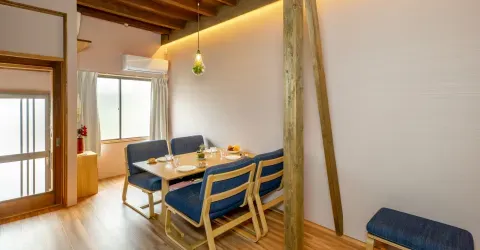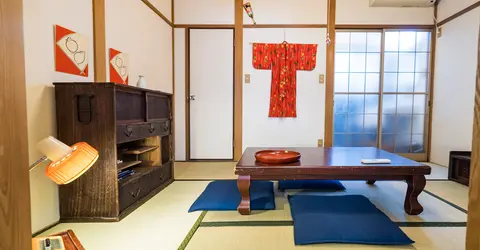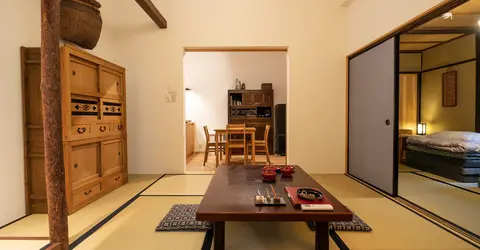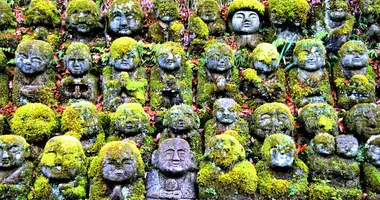Kamigamo Shrine
Kamigamo Shrine: read a guide to Kamigamo Shrine in north west Kyoto and sister shrine of Shimogamo Jinja.
Kamigamo Shrine 上賀茂神社

Kamigamo Jinja lies up against the northern hills, in a quiet residential area of Kyoto, and is therefore often less-crowded than shrines in the city centre, though no less impressive.
The shrine is a designated UNESCO World Heritage site, and most of the shrine buildings are classified as Important Cultural Properties.
Established in the 7th century, a hundred years before Kyoto was founded, Kamigamo Shrine is nevertheless about one hundred years younger than its sister shrine, Shimogamo Jinja. In fact Kamigamo and Shimogamo are the upper and lower halves of the same shrine.
 Priests' houses and the sacred stream Nara-no-ogawa, Kamigamo Shrine, Kyoto
Priests' houses and the sacred stream Nara-no-ogawa, Kamigamo Shrine, Kyoto
Both shrines were built by the powerful Kamo family who ruled over this area of mainly immigrants from the Korean Peninsula. During the 17th century over 275 households of descendants of the Kamo were living in the area, formed a shake-machi (社家町), a local association to protect and handle the affairs of Kamigamo Shrine.
Nishimura-Ke (Nishimura House) is one such shake-machi traditional priest's house and garden. The residence is open daily from March to December with admission 500 yen. The nearby Umetsuji Residence is open daily from July-September.
When the Imperial capital moved to Heiankyo (present day Kyoto) the Kamo shrines enjoyed imperial patronage and support that has continued to the present day.
Kamo Sai, the correct name for Aoi Matsuri, one of the 3 major festivals of Kyoto, ends here after beginning in the Imperial Palace and passing through Shimogamo Shrine. Aoi Matsuri features displays of horsemanship on the grass (see below) before the main shrine buildings.
One approaches the shrine across a large open space that is lawn, rather than the more usual gravel, and this gives Kamigamo Shrine the feel of a park.
The most unusual thing about Kamigamo Shrine is the two large sand cones that flank the entrance to the main shrine building - the Haiden. Known as Tatesuna, opinion differs as to their original meaning, but the most commonly accepted is that they represent the sacred mountain just to the north of the shrine. Small cones of salt outside restaurant entrances are said to derive from the Tatesuna. Another theory is that they were used to sprinkle on the paths leading to the shrine to purify them when a member of the nobility came to pray.
On September 9th the shrine holds the Crow Sumo ceremony (Karasu-zumo), where young boys from the neighborhood compete at sumo to entertain the gods. Before the sumo, shrine priests perform rituals while emulating the call and movements of crows, hence the name.
Entrance to the shrine is free, but at 9.30 am most mornings there is a short tour of the shrine including a purification ritual for which a 500 yen "donation" is asked.
With advance notice, groups can book a tour of the shrine and lecture in English, plus view some of the shrines treasures not normally open to the public.
Kamigamo Shrine is also a popular place for traditional Japanese weddings.
 Ema votive plaques, Kamigamo Shrine, Kyoto
Ema votive plaques, Kamigamo Shrine, Kyoto
 Shrine buildings, Kamigamo Shrine, Kyoto
Shrine buildings, Kamigamo Shrine, Kyoto
 Priests houses, Kamigamo Shrine, Kyoto
Priests houses, Kamigamo Shrine, Kyoto Sacred stream Nara-no-ogawa, Kamigamo Shrine, Kyoto
Sacred stream Nara-no-ogawa, Kamigamo Shrine, Kyoto
Kamigamo Shrine Access - how to reach Kamigamo Jinja
Access: Walk 10 minutes north from the Kitayama subway station. Or take a city bus to Kamigamojinja Mae or Kamigamo misonobashi stop.
Kamigamo Shrine can be reached by Kyoto Bus numbers 30, 32, 34, 35, 36, 37, 38, and 39, or Kyoto City Bus numbers 4, 46, and 67.
339 Motoyama, Kamigamo, Kita-ku, Kyoto
Tel: 075 781 0011
Admission: Free
By bicycle from Kitayama to Kamigamo.
Just outside the south entrance to Kamigamo Shrine are some fine clay-walled houses reached by short bridges over a canal. These are traditionally the residences of the priests of the shrine. Walking east along this road brings you to the delightful Ota Shrine which is famous for its irises which bloom in early May. The canal was dug both for defense and for irrigation purposes. The Kamigamo area is famous for its production of tsukemono pickles. Just past Ota Jinja is the Azekura noodle restaurant housed in a wooden, 300 year old sake warehouse, that was moved here from Nara. The garden at Azekura is also a delight.
Books on Kamigamo Shrine
Enduring Identities: The Guise of Shinto in Contemporary Japan explores the meaning of Shinto and was based on fieldwork carried out at Kamigamo Shrine over the course of a year.
 Kamigamo Shrine, Kyoto
Kamigamo Shrine, Kyoto





























